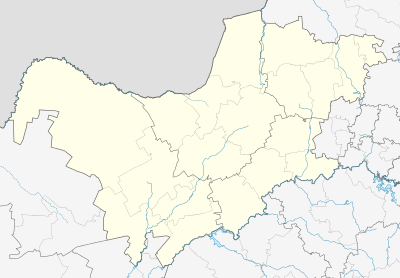Coligny, North West
| Coligny | |
|---|---|
|
Street in Coligny | |
 Coligny  Coligny  Coligny
| |
| Coordinates: 26°20′S 26°19′E / 26.333°S 26.317°ECoordinates: 26°20′S 26°19′E / 26.333°S 26.317°E | |
| Country | South Africa |
| Province | North West |
| District | Ngaka Modiri Molema |
| Municipality | Ditsobotla |
| Area[1] | |
| • Total | 4.36 km2 (1.68 sq mi) |
| Population (2011)[1] | |
| • Total | 2,271 |
| • Density | 520/km2 (1,300/sq mi) |
| Racial makeup (2011)[1] | |
| • Black African | 43.2% |
| • Coloured | 3.4% |
| • Indian/Asian | 1.9% |
| • White | 49.8% |
| • Other | 1.7% |
| First languages (2011)[1] | |
| • Afrikaans | 50.6% |
| • Tswana | 34.6% |
| • English | 6.6% |
| • Xhosa | 1.4% |
| • Other | 6.8% |
| Postal code (street) | 2725 |
| PO box | 2725 |
| Area code | 018 |
Coligny is a maize farming town situated next to the railway line between Lichtenburg and Johannesburg in North West Province of South Africa.
The town is situated c. 27 kilometres (17 mi) south-east of Lichtenburg. Originally named Treurfontein (Afrikaans: spring of sadness), it was renamed Coligny when it became a town on 23 July 1923, after Gaspard de Coligny, a Huguenot leader who died in the Massacre of St Bartholomew in 1572.[2] Coligny was the scene of sporadic diamond mining activities.
The Concordia Congregation (also known as Gerdau congregation after the origin of its first missionary) on farm Hakbosvlaakte was founded in 1905 and thus is older than the town. The church ran Gerdauer Gemeinde-Schule, a German-language school that operated successfully for 53 years.[3] This school was supported by German government and taught children from pre-school up to grade 7. In 1965 it had 2 teachers and 30 learners.[4]
References
- 1 2 3 4 "Main Place Coligny". Census 2011.
- ↑ Raper, Peter E. (1987). Dictionary of Southern African Place Names. Internet Archive. p. 122. Retrieved 28 August 2013.
- ↑ "Concordia-Gerdau Congregation" (PDF). Evangelical Lutheran Church in Southern Africa (N-T). Retrieved 15 August 2016.
- ↑ "Deutscher Bundestag 4. Wahlperiode Drucksache IV/3672" (Archive). Bundestag (West Germany). 23 June 1965. Retrieved on 12 March 2016. p. 30.

.svg.png)